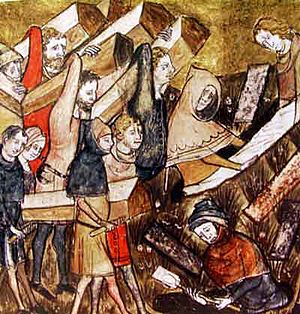Pandemic facts for kids
A pandemic (from Greek παν pan all + δήμος demos people) is an epidemic (an outbreak of an infectious disease) that spreads across a large region (for example a continent), or even worldwide.
Contents
Common killers and pandemics
According to the World Health Organization, a pandemic can start when three conditions have been met:
- the emergence of a disease new to the population.
- the agent infects humans, causing serious illness.
- the agent spreads easily and sustainably among humans.
A disease or condition is not a pandemic merely because it is widespread or kills many people; it must also be infectious. For example cancer is responsible for many deaths but is not considered a pandemic because the disease is not infectious (although certain causes of some types of cancer might be).
World Health Organization pandemic phases
The World Health Organization (WHO) has developed a plan to prepare globally the fight against influenza. It defines the stages of a pandemic and makes recommendations for national measures before and during a pandemic. The phases are:
Interpandemic period:
- Phase 1: No new influenza virus subtypes have been detected in humans.
- Phase 2: No new influenza virus subtypes have been detected in humans, but an animal variant threatens human disease.
Pandemic alert period:
- Phase 3: Human infection(s) with a new subtype but no human-to-human spread.
- Phase 4: Small cluster(s) with limited localized human-to-human transmission
- Phase 5: Larger cluster(s) but human-to-human spread still localized.
Pandemic period:
- Phase 6: Pandemic: increased and sustained transmission in general population.
Related pages
Images for kids
-
Early in the COVID-19 pandemic, convention centers (pictured here) were deemed to be ideal sites for temporary hospitals, due to their existing infrastructure (electrical, water, sewage). Hotels and dormitories were also considered appropriate because they can use negative pressure technology.
-
1918 Chicago newspaper headlines reflect mitigation strategies for the Spanish flu, such as increased ventilation, arrests for "open-face sneezes and coughs", sequenced inoculations, limitations on crowd size, selective closing of businesses, curfews, and lockdowns.
-
Illustration created at the Centers for Disease Control and Prevention (CDC), reveals xultrastructural morphology exhibited by coronaviruses; note the spikes that adorn the outer surface, which impart the look of a corona surrounding the virion.
See also
 In Spanish: Pandemia para niños
In Spanish: Pandemia para niños









